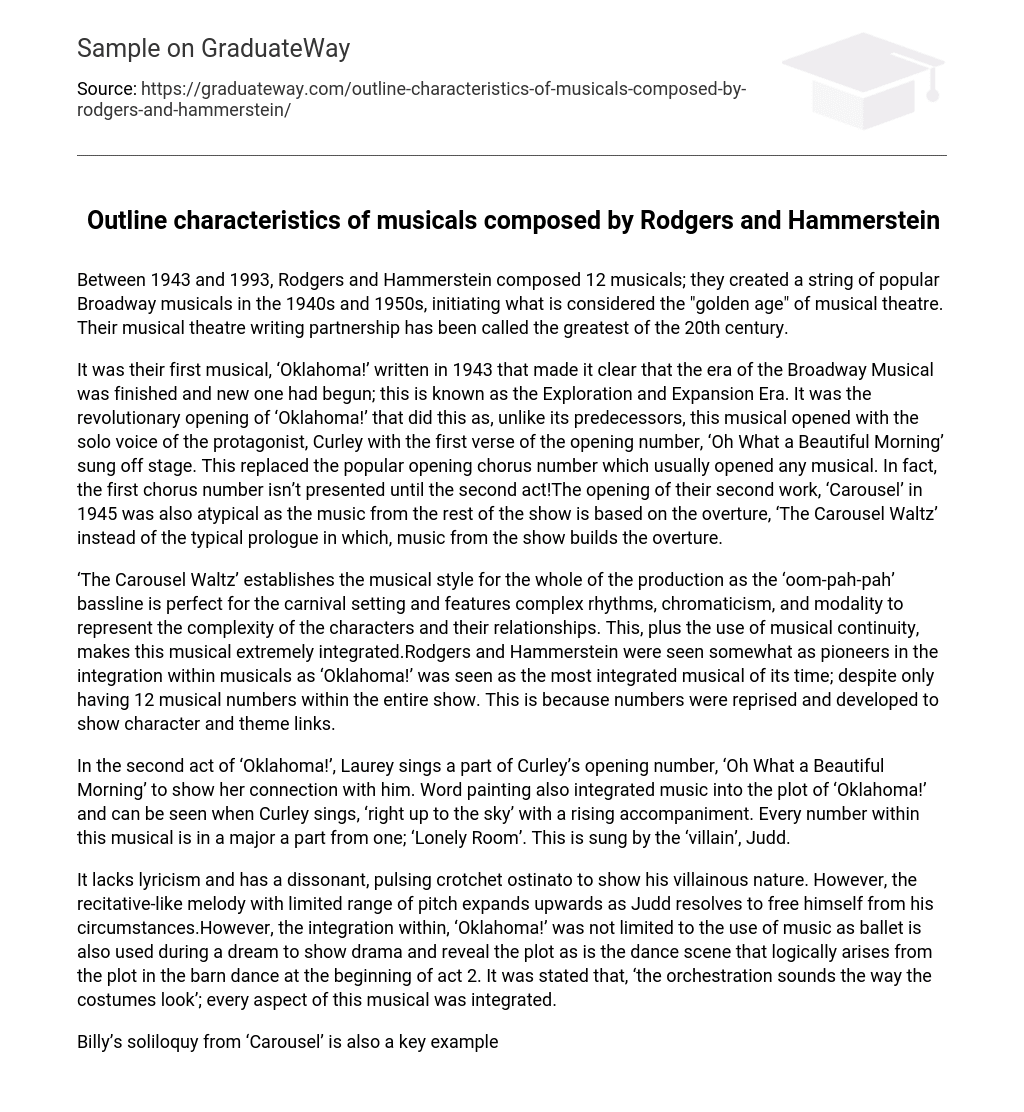Between 1943 and 1993, Rodgers and Hammerstein composed 12 musicals; they created a string of popular Broadway musicals in the 1940s and 1950s, initiating what is considered the “golden age” of musical theatre. Their musical theatre writing partnership has been called the greatest of the 20th century.
It was their first musical, ‘Oklahoma!’ written in 1943 that made it clear that the era of the Broadway Musical was finished and new one had begun; this is known as the Exploration and Expansion Era. It was the revolutionary opening of ‘Oklahoma!’ that did this as, unlike its predecessors, this musical opened with the solo voice of the protagonist, Curley with the first verse of the opening number, ‘Oh What a Beautiful Morning’ sung off stage. This replaced the popular opening chorus number which usually opened any musical. In fact, the first chorus number isn’t presented until the second act!The opening of their second work, ‘Carousel’ in 1945 was also atypical as the music from the rest of the show is based on the overture, ‘The Carousel Waltz’ instead of the typical prologue in which, music from the show builds the overture.
‘The Carousel Waltz’ establishes the musical style for the whole of the production as the ‘oom-pah-pah’ bassline is perfect for the carnival setting and features complex rhythms, chromaticism, and modality to represent the complexity of the characters and their relationships. This, plus the use of musical continuity, makes this musical extremely integrated.Rodgers and Hammerstein were seen somewhat as pioneers in the integration within musicals as ‘Oklahoma!’ was seen as the most integrated musical of its time; despite only having 12 musical numbers within the entire show. This is because numbers were reprised and developed to show character and theme links.
In the second act of ‘Oklahoma!’, Laurey sings a part of Curley’s opening number, ‘Oh What a Beautiful Morning’ to show her connection with him. Word painting also integrated music into the plot of ‘Oklahoma!’ and can be seen when Curley sings, ‘right up to the sky’ with a rising accompaniment. Every number within this musical is in a major a part from one; ‘Lonely Room’. This is sung by the ‘villain’, Judd.
It lacks lyricism and has a dissonant, pulsing crotchet ostinato to show his villainous nature. However, the recitative-like melody with limited range of pitch expands upwards as Judd resolves to free himself from his circumstances.However, the integration within, ‘Oklahoma!’ was not limited to the use of music as ballet is also used during a dream to show drama and reveal the plot as is the dance scene that logically arises from the plot in the barn dance at the beginning of act 2. It was stated that, ‘the orchestration sounds the way the costumes look’; every aspect of this musical was integrated.
Billy’s soliloquy from ‘Carousel’ is also a key example of musical integration as the music reveals so much about him, and his relationship with Julie. It is integrated into the music as spoken language turns into recitative before song to allow it to emerge from the drama seamlessly. This piece features musical continuity as it is in 4/4 but has the ‘oom-pah-pah’ bassline to show that the carnival is where he and Julie met, and contains dotted rhythms which are Julie’s leitmotif and triplets, which is the leitmotif of Billy and Julie’s relationship. This number modulates through several keys and strays away from the popular AABA song style to show Billy’s complex character.
Another characteristic of the pair’s work was the use of Romantic style idiom, most obvious through use of chromaticism. In the opening number of, ‘Oklahoma!’, a static note is repeated while the accompaniment rises below it; this provides romantic style tension before the cadence following this section. The strong melody with chromatic bass in ‘People Will Say We’re in Love’ is also reminiscent of the Romantic Style. Chromaticism is used again in ‘Carousel’ through the use of augmented chords in ‘The Carousel Waltz’.
To accompany Roger’s music, Hammerstein wrote deceptively simple lyrics which were apt and penetrating as the subtle use of rhyme and structure communicates complex ideas or emotions quickly and clearly. For example, in ‘Oklahoma!’, Curley instantly conveys his emotions while singing, ‘Oh what a beautiful morning. Oh what a beautiful day. I have a wonderful feeling, everything’s going my way.
’The final characteristic of musicals by Rodgers and Hammerstein is their use of long musical scenes. For example’ in ‘Carousel’, the Bench Scene begins with Billy’s recitative style philosophising and ends much later with the “almost love song”, ‘If I Loved You’. In addition, the opening of ‘Oklahoma!’ is extremely long and a mixture of song and dialogue and the repetition of some songs feature within this opening scene.Rodgers and Hammersteins’ works were seen as the pivotal point between the Broadway Musical Era and the Exploration and Expansion period mainly due to the new levels of integration they managed to incorporate into their works.





